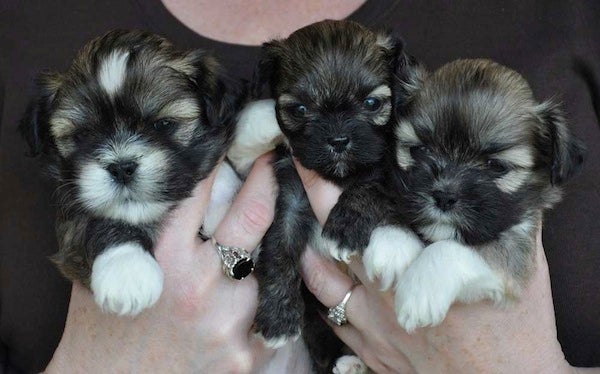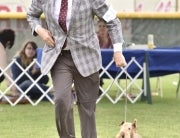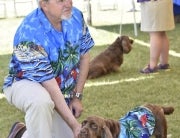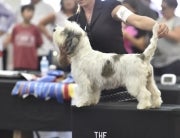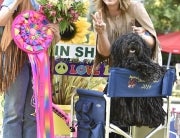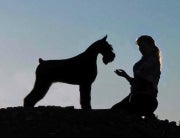This week we spoke with Tia McLaughlin, of Kumi Lhasa Apsos.
- Tell us a little about your personal history: How did you get started in dogs?
I grew up showing horses and was very successful. When it was time for the next phase in my life, I decided I wanted a Boxer, and I wanted a good one. I contacted a local breeder, who happened to have a show-potential bitch whom she was keeping. I convinced her to sell her to me, promising that I would show her. That was all it took, and I was hooked.
A couple of years later, I was introduced to Leslie Ann Engen, of San Jo Lhasas. Leslie and her mother, Marianne Nixon, had been in Lhasas for over 40 years. Actually, truth be told, I had heard from a Boxer friend of mine that her friend had just gone Best in Show that day. I was in awe of such a win and begged her to introduce me. That day I knew I wanted a Lhasa from her. I, too, was going to go Best in Show, and she would help me get there. That she did. She taught me how to groom, train, show, and breed Lhasas. Even now, after so many years, she continues to be a constant resource when I need advice.
Leslie introduced me to Ann Lanterman, of Kian Lhasas. Ann and Leslie had a litter with a very promising female available. That female was the foundation to my breeding program. Ann and I have been breeding and owning Lhasas together ever since.
- Why did you decide to handle your dogs yourself?
There was never a question about who would show my dogs. I knew it would be me. I’m way too competitive—I had to be in the ring! I was extremely lucky to have a mentor like Leslie to teach me everything I needed to know to handle my own dogs.
- How much do you work with a dog at home before handling him or her at shows?
In my breed there are hours of grooming done prior to actually getting to the shows. Lhasas need weekly, sometimes daily, maintenance. However, although grooming is essential, first and foremost a dog needs to be conditioned, both for stamina and for muscle. The night before a show involves about two to three hours of show grooming. There is another hour of grooming right before show time.
Aside from all the grooming, training and practicing is a must. I teach my dogs at home to stand on the table for examination. Then I lead-train them to be comfortable with a show lead and go at the speed that is best for them. I will also take them to handling classes to get them used to the show environment by practicing table work and ring work.
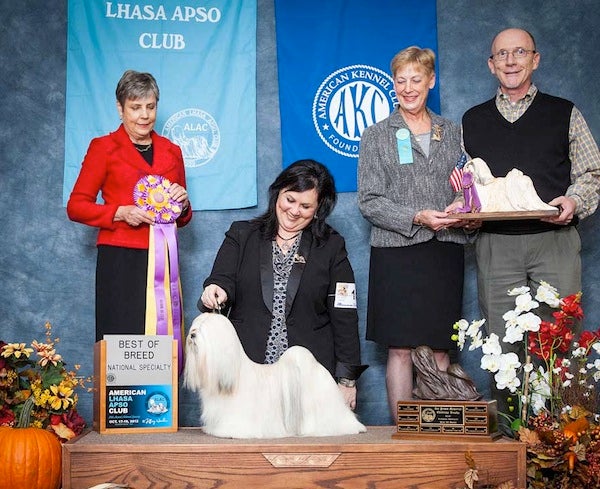
Winning the 2012 Lhasa Apso national under respected breeder-judge Mrs. Jan Bruton with BISS GCh. Kumi Kian Living the Dream, call name Snooki.
- What is your strategy on the use (or not) of bait?
I will do whatever is needed to show the dog to the best of my ability. If bait is what they like to keep their attention, then I will use bait. I try to keep it small so as not to hinder a judge looking at or going over my dog on the table. If a judge wants to look at the bite and the head, having bait in the dog’s face does not help that. I feel that if bait needs to be tossed in the ring, that is fine, but then it needs to be picked up right away and not left on the ground, out of courtesy to all the exhibitors in the ring. Some of my dogs prefer toys to bait. Again, I try to keep it small and not affect others with it.
- Do you get pre-ring jitters? If so, how do you deal with them?
Oh, yes! I have always had pre-ring jitters, even when I showed horses. I try to use my nerves to work for me. I get very focused on my dog and make sure we are as ready as possible prior to walking in the ring. Sometimes while waiting, I will brush my dog over and over again, and that is a result of nerves. It’s something to keep my hands busy and my mind focused. It’s kind of funny actually. I brush and brush … some of my friends laugh at me, but oh, well, it helps.

Showing Cyrus, BIS/MBISS/BISOH GCh. Kumi Kian Mion Parti in the USA, at the 2015 AKC/Eukanuba National Championship.
- What do you find to be the major benefits of showing your own dog?
The major benefit to showing my own dogs is they know me and know what I expect from them. We are bonded, and they want to make me happy, so they behave and do their best. The bond between a dog and his handler is very important. I also know everything about the dog I’m showing. I know the training they’ve had. I know their quirks or how they normally act in the ring. I know what bait or toy they like to help them perform at their best. Plus, I also know they are groomed as I like and are ring ready.
- What kinds of things have you learned from observing good handlers?
When I started showing, I knew I had a lot to learn. I would watch the handlers’ ring procedures and how they stacked their dogs. I also noticed that they were always dressed very professionally—men in suits, and women in skirts or dresses. To this day I only wear a skirt, suit, or dress. I’ve learned places to hide my bait when I don’t have pockets. I’ve learned I should smile more so as to not look so intense. I’ve also learned that no matter how you feel about the winner, you need to congratulate them.
- What are the biggest mistakes that you see new owner-handlers making?
Not learning enough about handling, and not training their dog. So often I see new people go in the ring, and it’s a straight-up train wreck from start to finish. They should have the dog trained to stand still for examination, show the bite without a fight, and move around the ring without diving for bait on the ground or running out of control. They should practice at home or in a handling class prior to stepping in the breed ring. Using the breed ring to train your dog is not a good idea.

Cyrus winning the Bred-by-Exhibitor Non Sporting Group under respected judge Johnny Shoemaker at the 2015 AKC/Eukanuba National Championship show.
- What are some interesting ring quirks of some of the dogs you’ve shown?
I’ve had dogs who will jump over the tape-strips that are holding down the mats. I’ve had dogs shy away from the wall in the ring.
- Who was the most difficult dog you have shown, and how did you handle that challenge?
My most difficult dog to show was a female named Daisy. She would lift her lip and growl very softly at judges who approached her when she was on the table for examination. Since it was so quiet and I could not see her raising her lip, I was once actually excused from the ring. I looked at the judge like she was crazy, because I did not believe that my dog was doing anything wrong. I asked a friend whom my dog didn’t know to come up to her like she was the judge. Sure enough, she was doing it. So Daisy and I had a behind-the-barn talk about this issue. I figured out if I stood in front of her with bait until the judge walked up, it kept her focused on me, and not the judge, which worked beautifully.
- Can you share with us a memorable moment, either amusing or embarrassing, that you have had as an owner-handler?
Oh, yes, I have a very amusing and embarrassing story to share. I was showing Daisy and was still very new to the dog show world. I had won the breed that day and also won the group. Oh, my, here I was going into the Best in Show ring with all the big handlers and their top-winning dogs! I was so nervous, but I went in and did my best.

The moment the judge at the 2015 Westminster dog show pointed at us and said “Best of Breed”—breeder-owner-handled Multi BIS/Multi BISS GCh. Kumi Kian Strike a Pose, call name Madonna.
Daisy was showing very well, and I was pleased with our performance. The judge walked over to the table and marked the book, and out she came with the big, beautiful ribbon. Next thing I know she says, “Today I’ll have the Lhasa.” I screamed, which scared Daisy, who then took off. I dove on the lead, then stepped on her tail getting up. By the time I got to the judge to accept the ribbon, I was in tears with joy. I told her it was my first Best in Show. I don’t think that surprised her, because of my actions. She said, “Well, well. Here, let me sign your ribbon.” She wrote, “Congrats on your first Best in Show” and signed it Jane Forsyth. Later I found out what an honor it was that she gave that Best to me and Daisy. I’ll never forget it.
- What is one of your most proud moments as an owner-handler?
I have so many actually, but I would have to say my most proud moment was when I won the breed with Madonna at Westminster. Oh, my goodness, what a thrill. To win at the Garden is every owner-handler’s dream. For me it was even that much sweeter because I was also her breeder! I will never forget that moment.
- What advice would you offer newcomers who are interested in handling their own dog in shows?
To be honest with yourself, always know your dog’s faults, and be open to learning. One more thing: Have fun! For us owner-handlers, it is not a job, it is a hobby—so have fun!


